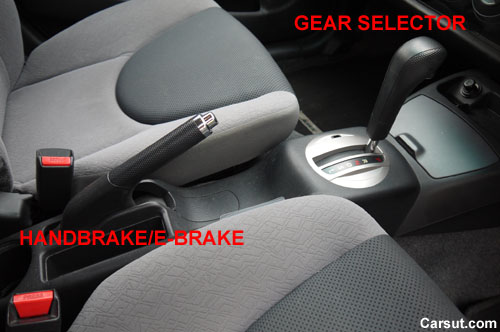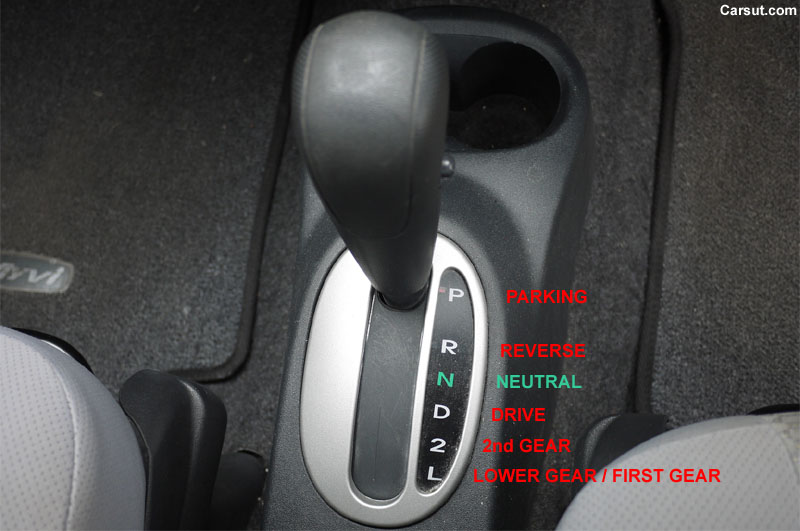Learning To Drive An Automatic Car
Learning to drive an automatic car will be faster and easier compared to manual transmission car. This is because the driver is not required to shift the gears manually. The car will go forward when the “D” (Drive mode) is engaged and it will reverse when the “R” mode is engaged. No clutch control is needed and you do not have to shift the gear manually. It is easier because you will only have to remember the gear knob, handbrake (e-brake), pedals, and steering wheel.
Understand an automatic transmission car

Once you are on the driving wheel, adjust the seat to a position where it fits you the best. There are only two pedals all the way down from the steering wheel. On the right is the gas pedal (petrol pedal) and on the left is brake pedal. If you are driving a RHD (Right-Hand-Drive) car, the gear knob and handbrake will be on your left and you need to use the left hand to control it. If you are driving a LHD (Left-Hand-Drive) car, the gear knob and handbrake will be on your right and use the right hand to manipulate it. Adjust the rear view mirror and two side mirrors so that you can clearly see if there is any vehicles coming from the back or both sides.

Study the gear selector
A standard automatic gear selector has the basic four markings:
P: Parking. Select P when you park your car.
R: Reverse. Select R when you want to reverse the car.
N: Neutral. Select N when you want to push the car or tow it.
D: Drive. Select D to drive the car.
Some cars will have extra markings other than the basic four above. It depends on how many speeds the automatic transmission has. Some cars like Honda or Toyota are equipped with five-speed automatic transmission. It is to allow the driver to have a better control to the car and sometimes it is useful to achieve slightly better mileage when driving in cities with heavy traffic jams. These are other automatic gear patterns found in some cars.
| Honda Civic | Honda Fit | Mini Cooper | Others | Others |
| P R N D D3 2 1 |
P R N D S L |
P R N D |
P R N D S |
P R N D L |
D3 or 3: This mode restricts the transmission to the first three gears, which means no matter how hard you throttle the gas pedal; the transmission will not change to fourth gear.
D2 or 2 or S (Slow): Shifting into this mode means the transmission will be locked in second gear. The car will start to run in first gear but only limits up to the second gear. It is very useful for driving up hill or driving in adverse conditions. It is also useful to increase the engine braking effect during downhill driving.
D1 or 1 or L (Low): Shifting into D1 or L indicates that the car will only run in first gear. This mode should only be engaged for towing, uphill, or downhill, otherwise the engine will be damaged if the RPM is too high.
Overdrive or OD or ‘O/D OFF’: This mode is only available in some cars. It can be found as a small button attached to the gear knob or located somewhere around it. The car will shift to lower gear when you turn it on. Use it when you want to over take or in circumstances that require a lower gear.
Step by step to drive an automatic car
Step 1: Make sure the handbrake is engaged and the gear knob is positioned at P (Parking). Some cars cannot be started if the gear is not in the P mode. Step on the brake pedal with your right foot and turn on the ignition to start the engine. There are some automatic cars that can only be started if the brake is applied.
Step 2: Press your right foot on the brake pedal and make sure the brake is still on. Shift the gear selector to D mode. Check if your gear knob has a button that locks the transmission. If there is, you will need to press it to shift the gear selector. You may feel the car jerking slightly on an old car.

Shift the gear selector to “D” (Drive).
Step 3: Look around to see if it is safe to take off. Then release the handbrake and lift your foot slowly off the brake pedal.
Step 4: Shift your right foot to the gas pedal. The more you step on the gas pedal, the faster the car will go.
Step 5: Slow down the car. To slow down the car, move your right foot from the gas pedal to the brake pedal. Step down the brake pedal gently and the car will stop.

Step 6: Making turns. When it comes to junctions, slow down the car and stop the car before the stop line if it is necessary. Turn the steering wheel towards the desired direction and step on the gas pedal gently.
Step 7: Stop at traffic. From time to time, you will have to stop the car at traffic. If the traffic is crawling (stop for a few seconds and then move for a few seconds), step on the brake pedal to temporarily stop the car and then engage the gear to N. If the traffic is heavy or the traffic lights just turn red (you are required to wait for a long time), select N and apply the handbrake firmly. This is to secure the car from being shoved if you are hit by any vehicles.
Step 8: Emergency brake. You should step on the brake pedal as hard as you can during emergencies. During the millisecond moments, make sure there is no vehicle trailing too close from behind.
Step 9: Reverse. The steps to reverse a car are similar to those of running the car in first gear. With the brake on, engage the R (Reverse) gear. Release the handbrake and lift your foot from the brake pedal gently. The car will go reverse slowly and step harder on the accelerator if you want to go faster.
Tips:
- Never EVER use both feet to drive an automatic car. It is incorrect to use the right foot for gas pedal and the left foot for brake. Use only the right foot to operate both pedals.
- Never use the handbrake to stop the car. The correct way to stop the car is to step on the brake pedal.
Click here to see the video of How To Drive An Automatic Car.




